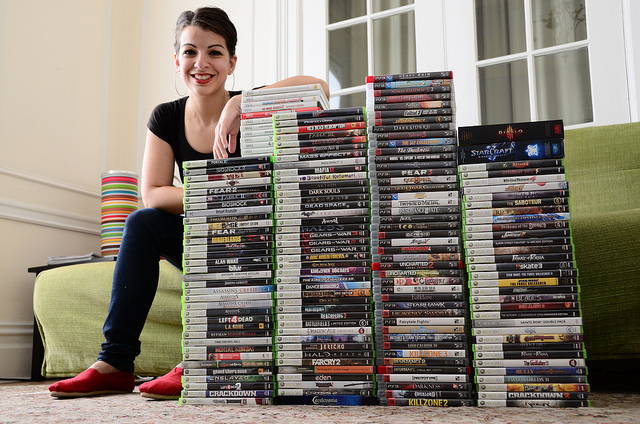Anita Sarkeesian V. the Internet: When Women Challenge Gamer Culture
“I’d like to share with you a story about how I accidentally became the villain of a massive online game, in real life,” opened Anita Sarkeesian at her TedxWomen talk in Washington, D.C. last year.
Anita Sarkeesian is a feminist and media critic, known for her YouTube channel, Feminist Frequency. On her channel, she covers a variety of topics including gendered toys, the Bechdel test, and retro sexism. She completed a series of videos for bitch magazine called “Tropes v. Women” in which she identified and broke down recurring sexist representations of women in films and television shows, such as the “manic pixie dream girl” and “women in refrigerators.”
“Women in refrigerators” is a trope where female characters experience a loss of superpowers, brutal violation, or an untimely death. Named for the 1994 issue of Green Lantern #54 in which Kyle Rayner finds that his girlfriend has been brutally murdered and stuffed into a refrigerator, these female characters are often killed, raped, or brutalized as plot points for the male character’s heroic journey. Sarkeesian aims to explain and deconstruct tropes like this while giving people the tools to talk about sexism in an accessible way.
In 2012, Sarkeesian launched a project on crowd-funding website Kickstarter titled “Tropes v. Women: Video Games.” Much like the previous “Tropes v. Women” series, she proposed exploring popular tropes of women, this time in the video game industry. And then, the Internet attacked.
Thousands of male gamers swarmed Sarkeesian’s social media accounts with [TRIGGER WARNING] threats of rape, violence, and death. They created pornographic images of her being raped by video game characters. Her Wikipedia page was vandalized with similar images and personal attacks. They even created a video game depicting Sarkeesian’s battered face while inviting the player to “beat the bitch up”. This was more than the typical sexist backlash or even just harassment—this was a massive online hate campaign. Sarkeesian thoroughly documented the abuse on her website, refusing to be silent.
And then, the Internet fought back. Just as online communities of gamers rallied around harassing Sarkeesian, numerous online communities banded together to support her. She exceeded her fundraising goal of $6,000 in just 24 hours and eventually raised $158,922. The incredible amount of donations has enabled her to commit to the project full-time. She has expanded the amount of videos she will produce from five to thirteen plus a classroom curriculum that educators can use for free.
Sarkeesian has also used the resulting media attention to raise awareness of the rampant sexism in gamer culture, particularly via her TedxWomen talk, in which she uses the analogy of an MMO (Massively Multiplayer Online Game) to explain how these large-scale cyber mobs operate. She has also participated in several interviews with popular news outlets such as Forbes and The New York Times. Sarkeesian is currently in the process of researching and creating videos for the new series. The first video launched in March 2013, clocking in at a respectable 23 minutes, the video has gained immense popularity in comparison to her previous five to ten minute videos.
It is important to note, however, that the men who instigated this harassment campaign were not fringe gamers. Due to the unequal power dynamics at play, men like this create gamer culture and ultimately act as its gatekeepers. The meme of the “fake gamer girl” is a powerful example of how this “gatekeeper” complex manifests itself in gamer culture. The idea of the fake gamer girl is nothing new, but recent discussions of this trope have been extrapolated from the popular image macros called “idiot nerd girl.” The top line contains a reference to nerd culture while the bottom line portrays a lack of knowledge about the subject. For example, one image reads “I love PC gaming / I play Farmville all day.” The basic idea behind the fake gamer girl is that women fake an interest in nerd culture in order to appear more attractive or desirable to men. Not only does this assume that women are primarily motivated by men’s perception of their actions, but it sets a standard of authentic “nerdiness” that simply isn’t applied to men. Women have to prove their nerd cred, men don’t.
The online hate campaign against Anita Sarkeesian and the “fake gamer girl” show us how resistant gamer culture is to criticism and change, and how far male gamers will go to maintain the boy’s club. Do video games often contain problematic representations of women? Of course. But that doesn’t mean that we can’t enjoy them and critique them at the same time. Identifying and challenging sexism in games is not a challenge to the games themselves, but rather to the structures that maintain and perpetuate that sexism. We clearly have a long way to go before gamer culture, and nerd culture in general, becomes accepting of women. But the fact that Sarkeesian’s campaign raised so much money despite the backlash against her is proof that there are plenty of gamers, feminists, and nerds out there who want to see female characters that are more than background decoration, fighting fucktoys, and damsels in distress. And we are willing to fight for it.
Taryn is a Scripps sophomore and Anthropology major who loves animals, the Internet, and kickass ladies like Anita.

![[in]Visible Magazine](https://community.scrippscollege.edu/invisible/wp-content/uploads/sites/5/2011/04/Invisible-Masthead-2011-Spring1.png)








No comments yet... Be the first to leave a reply!